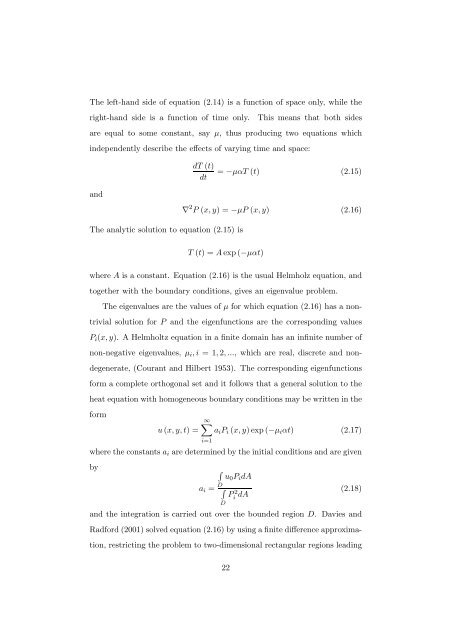Laplace transform isotherm .pdf - University of Hertfordshire ...
Laplace transform isotherm .pdf - University of Hertfordshire ...
Laplace transform isotherm .pdf - University of Hertfordshire ...
You also want an ePaper? Increase the reach of your titles
YUMPU automatically turns print PDFs into web optimized ePapers that Google loves.
The left-hand side <strong>of</strong> equation (2.14) is a function <strong>of</strong> space only, while the<br />
right-hand side is a function <strong>of</strong> time only. This means that both sides<br />
are equal to some constant, say µ, thus producing two equations which<br />
independently describe the effects <strong>of</strong> varying time and space:<br />
and<br />
dT (t)<br />
dt<br />
The analytic solution to equation (2.15) is<br />
= −µαT (t) (2.15)<br />
∇ 2 P (x,y) = −µP (x,y) (2.16)<br />
T (t) = Aexp (−µαt)<br />
where A is a constant. Equation (2.16) is the usual Helmholz equation, and<br />
together with the boundary conditions, gives an eigenvalue problem.<br />
The eigenvalues are the values <strong>of</strong> µ for which equation (2.16) has a non-<br />
trivial solution for P and the eigenfunctions are the corresponding values<br />
Pi(x,y). A Helmholtz equation in a finite domain has an infinite number <strong>of</strong><br />
non-negative eigenvalues, µi,i = 1,2,..., which are real, discrete and non-<br />
degenerate, (Courant and Hilbert 1953). The corresponding eigenfunctions<br />
form a complete orthogonal set and it follows that a general solution to the<br />
heat equation with homogeneous boundary conditions may be written in the<br />
form<br />
u(x,y,t) =<br />
∞�<br />
aiPi (x,y) exp (−µiαt) (2.17)<br />
i=1<br />
where the constants ai are determined by the initial conditions and are given<br />
by<br />
�<br />
u0PidA<br />
D<br />
ai = �<br />
D<br />
P 2<br />
i dA<br />
(2.18)<br />
and the integration is carried out over the bounded region D. Davies and<br />
Radford (2001) solved equation (2.16) by using a finite difference approxima-<br />
tion, restricting the problem to two-dimensional rectangular regions leading<br />
22

















